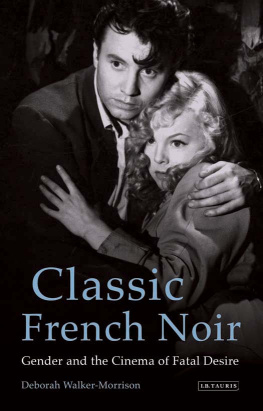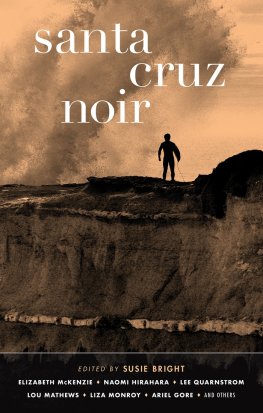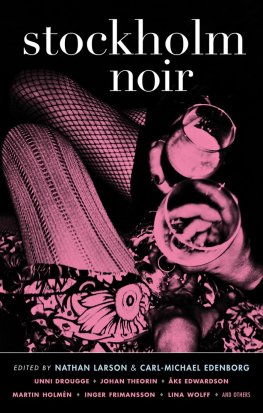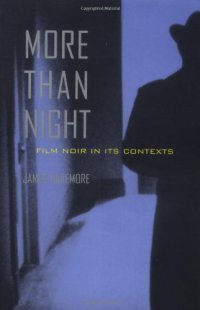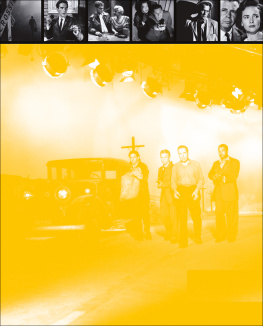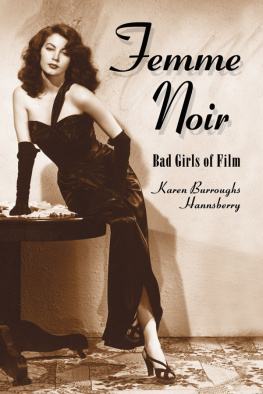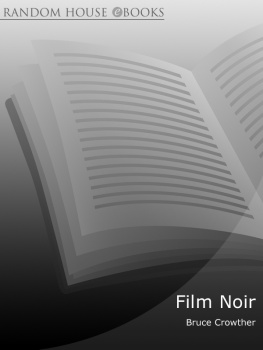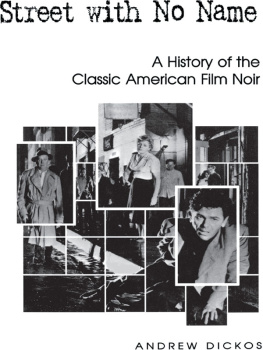
Deborah Walker-Morrison is Associate Professor of French at the University of Auckland, New Zealand. She has published widely on French cinema and is co-author (with Alistair Rolls) of French and American Noir: Dark Crossings (2009).
Walker-Morrison provides a fresh bio-cultural perspective on French film noir. This study forces us to reassess many classical-era films, their trans-national contexts, and especially their narrative functions in relation to gender, desire, and, of course, death.
Richard Neupert, Wheatley Professor of the Arts,
University of Georgia, USA
Providing convincing academic insights of femmes fatales and hard-boiled detectives, Walker-Morrison explores French film noir by taking a Corporeal Turn, centring the issues on the body and bodily life.
Laurent Jullier, Professor of Film Studies,
Universit de Lorraine, France and Director of
Research at IRCAV Sorbonne Nouvelle, France
This book is an invigorating breath of fresh air. Conventional wisdom has postwar French cinema as misogynistic and sterile, but Deborah Walker-Morrisons bracing biocultural inquiry turns classical Gallic noir into a fascinating hotbed of gender intrigue and sociocultural debate. Scrupulously researched, crisply written, this is essential reading for anyone interested in film noir or French cinema.
Tim Palmer, Professor of Film Studies,
University of North Carolina at Wilmington,
USA and author of Brutal Intimacy:
Analyzing Contemporary French Cinema (2011)
and Irreversible (2015)

For Neil
Published in 2019 by
I.B.Tauris & Co. Ltd
London New York
www.ibtauris.com
Copyright 2019 Deborah Walker-Morrison
The right of Deborah Walker-Morrison to be identified as the author of this work has been asserted by the author in accordance with the Copyright, Designs and Patents Act 1988.
All rights reserved. Except for brief quotations in a review, this book, or any part thereof, may not be reproduced, stored in or introduced into a retrieval system, or transmitted, in any form or by any means, electronic, mechanical, photocopying, recording or otherwise, without the prior written permission of the publisher.
Every attempt has been made to gain permission for the use of the images in this book. Any omissions will be rectified in future editions.
References to websites were correct at the time of writing.
International Library of the Moving Image 57
ISBN: 978 1 78453 971 9
eISBN: 978 1 78673 518 8
ePDF: 978 1 78672 518 9
A full CIP record for this book is available from the British Library
A full CIP record is available from the Library of Congress
Library of Congress Catalog Card Number: available
Contents
List of Illustrations
Figures
La bte humaine
La bte humaine
Human Desire
Human Desire
Le corbeau
Les hros sont fatigus
Les hros sont fatigus
Manon
Manon
Martin Roumagnac
Casque dor
Martin Roumagnac
Jirai cracher sur vos tombes
Le dernier tournant
The Postman Always Rings Twice
Thrse Raquin
Ascenseur pour lchafaud
Ascenseur pour lchafaud
Les Diaboliques
Voici le temps des Assassins
Retour de Manivelle
La vrit sur Bb Donge
Bonnes tuer
Une Manche et la Belle
La Bte LAfft
Quai des Orfvres
Le dsordre et la nuit
En cas de Malheur
Bob Le Flambeur
Du Rififi chez les hommes
Touchez pas au Grisbi
Du Rififi chez les hommes
Tables
Effect of World War II (194060) on operational sex ratios and marriage markets in France and USA
The comparative popularity of Classic French noir
Demonic fatale, amoureuse* or garce as major antagonist
Homme fatal* as duplicitous seducer, redeemed homme(*) or evil/flawed male anti-hero
Romantic fatalitaire or good-bad girl as protagonist (star-crossed lovers* 18) 33/75
Acknowledgements
Classic French Noir is the fruit of over 15 years thinking, research and writing in the field of film noir. Thus I have many people and organisations to thank. First, thanks to Phil Powrie, Susan Hayward and Ginette Vincendeau, organisers of the Annual French Cinema Studies Conference, London 2002, for hosting my very first paper on the subject, which examined the quasi absence of the spider-woman femme fatale in French film noir.
Since then, preliminary research and early chapter drafts have been presented at a number of international conferences. In particular I would like to thank the Society of Cognitive Studies for hosting papers at annual conferences in 2011 and 2016, and Marieke Krajenbrink and Kate Quinn, organisers of the Sixth Interdisciplinary Conference of the International Crime Genre Research Network, Ireland, Consuming Crime, Limerick, 2015, at which I presented preliminary research for .
Sections in (Walker-Morrison 2015).
Carrying out French research from Antipodean Auckland, Aotearoa/New Zealand, can be a challenge. I am therefore especially grateful to staff of French film and research libraries in Paris: the Bibliothque Nationale Franois Mitterrand, LInathque, the Bibliothque du Film and the Iconothque at the Cinmathque franaise, for their invaluable assistance during my numerous short research trips to the City of Lights. Closer to home, I also thank staff at the University of Auckland Library for their tireless efforts in procuring DVDs of rare films and facilitating access to French databases. Thanks also to the team at CBO Box Office for providing an invaluable resource, and for being quick to update and add entries in response to requests.
Friends, family, colleagues and students have contributed directly and indirectly to the book. First, thanks to my husband Neil Morrison, for years of patience and support, especially during moments of writers block, research fatigue and manuscript panic, and for enthusiastic feedback on successive drafts. Thanks to Bob Swaim and Franois Thomas for hours of caf conversations and encouragement during my stays in Paris. Thanks to Pascal Bensadoun for sharing off-air recordings of classic films. Thanks to friends who have provided hospitality in Paris and London, in particular Termis Tousson, Chikako Inoue, Sabine Bernert and Brigitte Gauthier. And to Cendrine Jarraud-Leblanc, thanks for providing the perfect writing retreat, in the South of France. To my colleague and friend, Emerita Professor Raylene Ramsay, thanks for casting a keen and generous eye over the revised manuscript. Thanks to students of France on Screen, from Lumire to Godard, whose questions, comments and curiosity have been a constant source of encouragement and inspiration.
I began using evolutionary theory to examine gender in noir at a time when such an approach was viewed with scepticism and distrust by the majority of film scholars. I therefore extend a special thanks to Distinguished Professor Brian Boyd of the University of Auckland, for his wisdom and support, for introducing me to leading scholars of evolutionary and biocultural approaches to film and literature, and for insightful comments on a draft of my early work (Walker 2007).
This project was generously supported by successive grants from within the University of Auckland: the School of European Languages and Literatures, the School of Cultures, Languages and Linguistics, and the Faculty of Arts. I am grateful to Campbell Birch, Philippe Valax and Ian Fookes for research assistance, and to Tim Page for assistance with the images.
Next page
